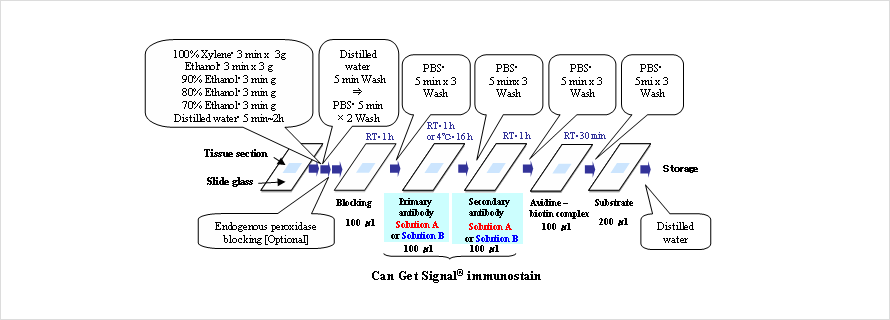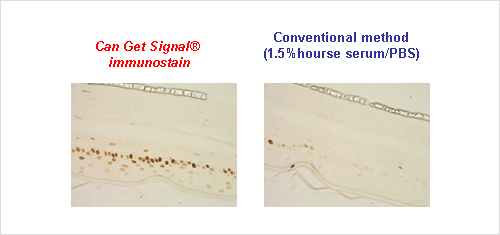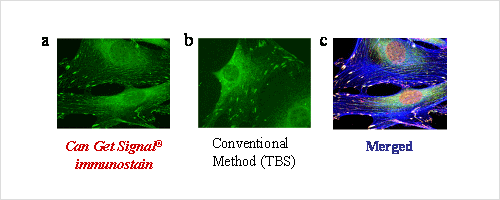- HOME
- Immunoreaction Enhancer Solution Can Get SignalTM immunostain
-
Immunoreaction Enhancer Solution
Can Get SignalTM immunostain
Code No. NKB-401 5 mL x 2 / NKB-501 20 mL x 1 / NKB-601 20 mL x 1
DESCRIPTION
-
-
Can Get Signal™ immunostain is a reaction solution that contains an accelerator for antigen-antibody reactions, which improves sensitivity, specificity, and S/N of immunohistochemistry (IHC) and immunocytochemistry.
-
Features
- ・Improves sensitivity, specificity, and S/N of IHC.
- ・Can be applied to various detection systems (e.g., chromogenic, chemiluminescence, or fluorescence).
- ・Can be used with ABC or polymer complex methods.
- ・Solutions A and B exhibit various properties for improving results.
- ・Can be used directly without dilution (Ready-to-use).

Details
Applications
- ・Immunohistochemistry (IHC)
- ・Immunocytochemistry
Storage condition
Store at 4ºC
Components
This kit includes the following components. All reagents should be stored at 4ºC and protected from light.
| Reagent Name | Code No. | ||
|---|---|---|---|
| NKB-401 | NKB-501 | NKB-601 | |
| Solution A | 5 mL | 20 mL | - |
| Solution B | 5 mL | - | 20 mL |
Typical reaction flow

Flow chart of immunostaining with Can Get Signal™ immunostain
Application Data
Example 1.Detection of PCNA using paraffin-embedded sections
The localization of PCNA (proliferating cell nuclear antigen) expression in human skin was detected using paraffin-embedded sections of the human skin tissue model TESTSKINTM (Toyobo). Detection was performed by the ABC method with anti-PCNA mouse monoclonal antibody as the primary antibody and biotinylated mouse IgG as the secondary antibody. Each antibody was diluted with Solution A of Can Get Signal™ immunostain prior to use. As a control experiment, PBS(-) containing 1.5% normal horse serum (conventional method) was used instead of Solution A of Can Get Signal™ immunostain. As a result, Can Get Signal™ immunostain produced higher signals and lower background than the conventional method.

Fig. 1. IHC detection of PCNA using paraffin-embedded tissue sections
Example 2. Detection of paxillin with the fluorescent antibody method
The localization of paxillin in Swiss 3T3 cells was detected using anti-paxillin polyclonal antibody and Alexa488-conjugated rabbit IgG antibody. As a result, the exposure time for detection could be reduced from 3 s to 1 s by using Can Get Signal™ immunostain, and the detailed fiber structure (fibrillar adhesion) could also be detected by using Can Get Signal™ immunostain. However, the structure could not be detected with the conventional method due to high background signals.
Fig. 2C shows a merged picture of the immunological detection with anti-paxillin and anti-phospho-tyrosine antibodies, and actin staining.

Fig. 2. Immunocytochemistry detection of paxillin with the fluorescent antibody method
*The data was kindly provided by Dr. Harada, Tokyo Institute of Technology.
